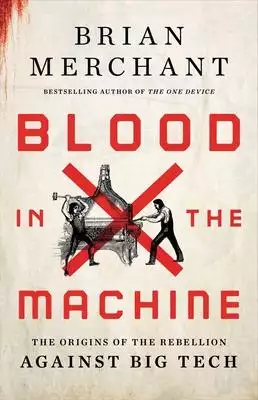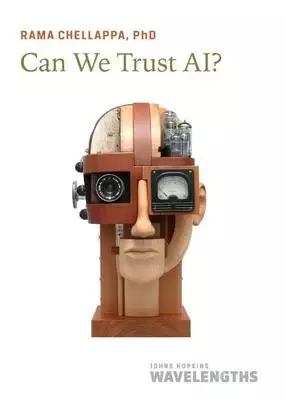What is artificial i的問題,透過圖書和論文來找解法和答案更準確安心。 我們找到下列地圖、推薦、景點和餐廳等資訊懶人包
What is artificial i的問題,我們搜遍了碩博士論文和台灣出版的書籍,推薦Merchant, Brian寫的 Blood in the Machine: The Origins of the Rebellion Against Big Tech 和Chellappa, Rama的 Can We Trust Ai?都 可以從中找到所需的評價。
這兩本書分別來自 和所出版 。
明志科技大學 視覺傳達設計系碩士班 劉瑞芬所指導 林貞瑜的 設計趨勢預測應用於設計思考流程之研究 (2021),提出What is artificial i關鍵因素是什麼,來自於設計趨勢、預測方法、設計思考、設計流程。
而第二篇論文國立陽明交通大學 材料科學與工程學系所 鄒年棣所指導 許家維的 基於深度學習進行電池性質預測 (2021),提出因為有 鋰離子電池、老化因子、剩餘壽命、深度學習、特徵篩選、時序資料處理的重點而找出了 What is artificial i的解答。
除了What is artificial i,大家也想知道這些:
Blood in the Machine: The Origins of the Rebellion Against Big Tech

為了解決What is artificial i 的問題,作者Merchant, Brian 這樣論述:
The true story of what happened the first time machines came for human jobs, when an underground network of 19th century rebels, the Luddites, took up arms against the industrialists that were automating their work--and how it explains the power, threat, and toll of big tech today. The most press
ing story in modern tech begins not in Silicon Valley, Seattle, or even Shenzhen. It begins two hundred years ago in rural England, when working men and women rose up en masse rather than starve at the hands of the factory owners who were using machines to erase and degrade their livelihoods. They
organized guerilla raids, smashed those machines, and embarked on full-scale assaults against the wealthy machine owners. They won the support of Lord Byron, inspired Mary Shelley, and enraged the Prince Regent and his bloodthirsty government. Before it was over, much blood would be spilled--of rich
and poor, of the invisible and of the powerful. This all-but-forgotten and deeply misunderstood class struggle nearly brought 19th century England to its knees. We live now in the second machine age, when similar fears that big tech is dominating our lives and machines replacing human labor run hi
gh. We worry that technology imperils millions of jobs, robots are ousting workers from factories, and artificial intelligence will soon remove drivers from cars. How will this all reshape our economy and the way we live? And what can we do about it? The answers lie in the story of our first machin
e age, when mechanization first came to British factories at the beginning of the industrial revolution. Intertwined with a lucid examination of our current age, the story of the Luddites, the working-class insurgency that took up arms against automation (at a time when it was punishable by death to
break a machine), Blood in the Machine reaches through time and space to tell a story about how technology changed our world--and how it’s already changing our future.
What is artificial i進入發燒排行的影片
皆さん見てくれてありがとうございます(*ノェノ)
君の名は。の宮水三葉コスプレです。
今更ながらの君の名は。ですが、神社・鳥居といえば三葉。
三葉といえば、瀧くんということで
劇中にはないようなセリフを言ってもらいました。
全力で階段おります。
※毎週火・金曜日の夜9時に動画あっぷしています!
気になる方は、ぜひチャンネル登録宜しくおねがいします。
チャンネル登録ボタンのベルマークを押してもらえると動画が上がったら通知が行くので、ベルマークもポチッとお願いします(*´ω`*)
チャンネル登録&高評価お願いします☆
Subscribe & please rate highly ☆
★LINEスタンプ販売スタートしました!
その名も【うみみみな 日常 スタンプ】
日常で使える32種類のスタンプ!!!
使い倒してください★
下記のURLをクリックすると販売ページに飛びます!
https://line.me/S/sticker/8831377/?lang=ja&ref=gnsh_stickerDetail
皆さん、みみなスタンプよろしくおねがいしますm(_ _)m
☆みみなのオススメ動画☆
■相方めーちゃんファンの方へ■
【神回】みみなお色気水着か!めーちゃん顔公開か!ラップ解き対決!【すーぱーそに子】【ナースコスプレ】
→ https://youtu.be/ocZeFD8Hhx0
■服作りシリーズ■
◇服作り第一弾◇
綿菓子を使って食べられる洋服を作ってみた!【綿菓子コスプレ】
Cotton candy clothes eat Make it
↓
https://www.youtube.com/watch?v=0nHNcQmXh9w
◇服作り第二弾◇
巨大スライムで洋服作り!材料3つで失敗しない簡単スライムの作り方【スライムコスプレ】
Making clothes with huge slime
↓
https://www.youtube.com/watch?v=-3ZiVBe2A_s
◇服作り第三弾◇
クッキーと生クリームで洋服作り!お菓子の家が作れる技公開!
Make clothes with Candy clothes! 【クッキーコスプレ】
↓
https://youtu.be/1PQ8ZlV4X80
◇服作り第四段◇
レゴ ブロックで服作り!のはずが想像を遥かに超えた作品ができてしまった Make clothes with Lego! I made more clothes than I expected.
↓
https://youtu.be/iaRT7iQjgFM
◇服作り第五段◇
風船で洋服作り!ハプニングあったけどアートでオシャレで可愛い作品が出来上がった Make clothes with balloons! Happening art fashionable cute
↓
https://youtu.be/U_slZNSpLGs
◇服作り第六段◇
造花で夏を先取りアイドルになれる衣装を作ってみた!第6段 Artificial flower summer idol costume made
↓
https://youtu.be/Uh9hp6qBXNE
◇服作り第七段◇
【コスプレ】不思議の国のアリスのトランプになってみた トランプ服 Halloween Alice in Wonderland Trump Anthropomorphization
↓
https://www.youtube.com/watch?v=WK8Pj6h4dgE&t=188s
■女性必見 美容、健康系■
◇全身美白パックで日焼け肌はどこまで白肌になるのか!?
Fair whitening white skin whole body pack
↓
https://www.youtube.com/watch?v=1nmMTz5fifU
◇バストアップ(育乳) 筋トレーニング !!Bustup muscle training
↓
https://www.youtube.com/watch?v=NR-iNtkMry4
◇着圧ストッキングと加圧トレーニングマシーンでどこまで脚痩せするか検証!How to make your legs thinner
↓
https://www.youtube.com/watch?v=EIPhuLKRAgo
◇【女性必見】くびれマッサージ1000回でどれだけくびれるのか検証
Neck massage verification Making
↓
https://www.youtube.com/watch?v=lL36L1VR6YQ
◇精力剤飲んだ効果を数値化したら凄かった!自律神経測定で活動力upした!!【FLIR ONE】
↓
https://www.youtube.com/watch?v=tBYQK-fVJWc
◇激痛!効果抜群!健康足つぼマッサージで大絶叫
Severe pain foot pot
↓
https://www.youtube.com/watch?v=6bZroUGnKO8
◇【効果絶大】10分で鼻詰まり!蓄膿症!花粉症!鼻炎解消!驚きの効果!
Secondary nasal inflammation improvement
↓
https://www.youtube.com/watch?v=KcJPo3EwMI8&t=2s
■質問コーナー■
◇〇ッチは週何回? 年齢は? 皆の質問に何でも応えます。
Question corner
↓
https://www.youtube.com/watch?v=Gq5tyMHdwPc&t=189s
***みみなチャンネル(メイン)***
https://www.youtube.com/channel/UCm90W5OQQfqR6g9802fYK8g
***セカンドチャンネル***
http://urx.blue/2LVp
***Instagram***
http://urx3.nu/O8Kx
***Facebook***
http://ur0.link/NE8q
***Twitter***
http://ur0.link/NE8s
フォロー、いいねよろしくおねがいします★★
Following, I hope so★★
#制服 #君の名は。 #コスプレ
設計趨勢預測應用於設計思考流程之研究
為了解決What is artificial i 的問題,作者林貞瑜 這樣論述:
台灣近年愈來愈重視設計產業,政府提倡將設計作爲企業的目標策略與核心,不過目前許多政策仍在規劃階段,只有少數成功的大型企業,早已開始進行設計趨勢相關的研究工作,因此本研究動機為瞭解企業執行設計趨勢的目的與過程,以及對設計師的影響。本研究採用質性研究中的半結構式訪談,以台灣本土大型科技企業之設計中心作為本研究之個案,透過研究目的:一、瞭解企業內部如何進行設計趨勢預測與彙整。二、企業內之設計師如何應用設計趨勢進行設計思考與發想。三、設計趨勢對於企業內的設計師的影響為何。以及文獻探討的歸納,聚焦於企業中執行設計趨勢預測與設計思考之流程及應用,以及企業內之設計師認為趨勢預測之於個人或公司之影響,訪綱分
為四大類,共26道題目,分別訪談八位參與過設計趨勢研究之設計師,從中瞭解設計趨勢的重要性。本研究依照企業內部設計師們所提供的經驗與建議,研究者根據訪談結果提出下列點結論:1、企業內之設計中心執行趨勢,會綜合多種不同形式的團體預測方法使用,每年無固定使用之方法,會依據人員、目標的不同去做調整,訂定趨勢結論。;2、企業全體人員可從宏觀趨勢抓取機會點,在成立新專案時導入,而設計人員可從設計趨勢抓取應用面,在設計發想時導入使用,或是設計提案時導入設計理念中。;3、設計趨勢對於設計師而言,是一個與時俱進的工具書,使設計作品在產業界的壽命更加長遠。4.趨勢研究結果不需要強制在設計中心內部去做驗證,可以從市
場回饋中得到答案。
Can We Trust Ai?

為了解決What is artificial i 的問題,作者Chellappa, Rama 這樣論述:
Artificial intelligence is part of our daily lives. How can we address its limitations and guide its use for the benefit of communities worldwide?Artificial intelligence (AI) has evolved from an experimental computer algorithm used by academic researchers to a commercially reliable method of sift
ing through large sets of data that detect patterns not readily apparent through more rudimentary search tools. As a result, AI-based programs are helping doctors make more informed decisions about patient care, city planners align roads and highways to reduce traffic congestion with better efficien
cy, and merchants scan financial transactions to quickly flag suspicious purchases. But as AI applications grow, concerns have increased, too, including worries about applications that amplify existing biases in business practices and about the safety of self-driving vehicles. In Can We Trust AI?, D
r. Rama Chellappa, a researcher and innovator with 40 years in the field, recounts the evolution of AI, its current uses, and how it will drive industries and shape lives in the future. Leading AI researchers, thought leaders, and entrepreneurs contribute their expertise as well on how AI works, wha
t we can expect from it, and how it can be harnessed to make our lives not only safer and more convenient but also more equitable. Can We Trust AI? is essential reading for anyone who wants to understand the potential--and pitfalls--of artificial intelligence. The book features: - an exploration of
AI’s origins during the post-World War II era through the computer revolution of the 1960s and 1970s, and its explosion among technology firms since 2012;- highlights of innovative ways that AI can diagnose medical conditions more quickly and accurately;- explanations of how the combination of AI an
d robotics is changing how we drive; and- interviews with leading AI researchers who are pushing the boundaries of AI for the world’s benefit and working to make its applications safer and more just. Johns Hopkins WavelengthsIn classrooms, field stations, and laboratories in Baltimore and around the
world, the Bloomberg Distinguished Professors of Johns Hopkins University are opening the boundaries of our understanding of many of the world’s most complex challenges. The Johns Hopkins Wavelengths book series brings readers inside their stories, illustrating how their pioneering discoveries and
innovations benefit people in their neighborhoods and across the globe in artificial intelligence, cancer research, food systems’ environmental impacts, health equity, planetary science, science diplomacy, and other critical arenas of study. Through these compelling narratives, their insights will s
park conversations from dorm rooms to dining rooms to boardrooms.
基於深度學習進行電池性質預測
為了解決What is artificial i 的問題,作者許家維 這樣論述:
鋰離子電池作為常見的儲能設備,廣泛應用於終端設備上且藉由電池管理系統進行監控確保電池老化程度仍可應付工作所需。然而電池在使用初期並無明顯老化特性的反應,因此對於使用過的電池無法很好評估預期壽命以至於材料的浪費或設備的異常(Early failure)。本研究利用時序資料連續性進行資料擴增更同時對神經網路潛空間進行正則化,並透過包含篩選器與預測器的神經網路架構在僅有少量循環的量測數據下,預測電池產品壽命、剩餘使用壽命、充電所需時間、放電時的電壓電量變化曲線等。其中,僅測量一個充放電完整循環的數據,就能提供僅有57週期方均根誤差的產品壽命預測。本研究亦同時引入注意力機制於此框架中達成僅使用若干個
循環的測量資料便可預測整個電池的產品週期放電電量、放電功耗等特性。